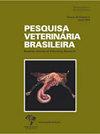Urea poisoning in cattle: A brief review and diagnostic approach
IF 0.8
4区 农林科学
Q3 VETERINARY SCIENCES
引用次数: 1
Abstract
ABSTRACT: Urea is an organic compound characterized as a white, solid, and hygroscopic substance. It is recognized as a source of non-protein nitrogen (NPN) and is widely used as a partial replacement for protein in cattle diets due to the ability of the ruminal microbiota to convert it into microbial protein. Despite the advantages of using urea, it also has limitations, particularly the proximity between metabolizable and toxic or fatal doses. Furthermore, for safe use, a period of adaptation is necessary for the animals. Poisoning is characterized by rapid and generally fatal development, which is frequent in non-adapted animals but can also occur in those with previous adaptations. The aim of this study was to characterize the clinical, epidemiological, and pathological aspects of urea poisoning through a brief review and a retrospective study. In addition, interviews were conducted with veterinarians who frequently send diagnostic material to the Laboratory of Anatomic Pathology of the “Faculdade de Medicina Veterinária e Zootecnia” (LAP-FAMEZ) to assess their perception of the outbreaks of urea poisoning. The objective was to obtain a comparative scenario between published cases and those received by the laboratory while considering the real situation of this condition in the field. During this retrospective study, only four outbreaks were investigated; in one, the diagnosis was possible through experimental reproduction. Of 35 interviewees, 88.9% said they had seen more than one case compatible with urea poisoning, but 87.5% did not perform a necropsy and/or send material to confirm the diagnosis. The results show that the reality of urea poisoning may be very distant from that reported in previous studies due to the difficulty often observed in the diagnostic approach, so we developed a flowchart aiming to provide a useful guide for field veterinarians.牛尿素中毒:简要回顾和诊断方法
摘要:尿素是一种白色固体、吸湿性有机化合物。它被认为是非蛋白氮(NPN)的一种来源,由于瘤胃微生物群能够将其转化为微生物蛋白,因此被广泛用作牛日粮中蛋白质的部分替代品。尽管使用尿素有优点,但它也有局限性,特别是在代谢剂量和有毒或致命剂量之间的接近。此外,为了安全使用,动物需要一段适应期。中毒的特点是迅速和通常致命的发展,这在未适应的动物中很常见,但也可能发生在以前适应过的动物中。本研究的目的是通过一个简短的回顾和回顾性研究来描述尿素中毒的临床、流行病学和病理学方面。此外,还采访了经常向“医学学院Veterinária e Zootecnia”(LAP-FAMEZ)解剖病理学实验室发送诊断材料的兽医,以评估他们对尿素中毒爆发的看法。目的是在考虑到实地这种情况的真实情况的同时,获得已公布病例和实验室收到的病例之间的比较情况。在这项回顾性研究中,仅调查了4次疫情;在其中一种情况下,诊断是通过实验性繁殖实现的。在35名受访者中,88.9%的人说他们见过不止一个与尿素中毒相符的病例,但87.5%的人没有进行尸检和/或寄送材料以确认诊断。结果表明,尿素中毒的真实情况可能与以往的研究报告相去甚远,因为在诊断方法中经常观察到困难,因此我们制定了一个流程图,旨在为现场兽医提供有用的指导。
本文章由计算机程序翻译,如有差异,请以英文原文为准。
求助全文
约1分钟内获得全文
求助全文
来源期刊

Pesquisa Veterinaria Brasileira
农林科学-兽医学
CiteScore
1.30
自引率
16.70%
发文量
41
审稿时长
9-18 weeks
期刊介绍:
Pesquisa Veterinária Brasileira - Brazilian Journal of Veterinary Research (http://www.pvb.com.br), edited by the Brazilian College of Animal Pathology in partnership with the Brazilian Agricultural Research Organization (Embrapa) and in collaboration with other veterinary scientific associations, publishes original papers on animal diseases and related subjects. Critical review articles should be written in support of original investigation. The editors assume that papers submitted are not being considered for publication in other journals and do not contain material which has already been published. Submitted papers are peer reviewed.
The abbreviated title of Pesquisa Veterinária Brasileira is Pesqui. Vet. Bras.
 求助内容:
求助内容: 应助结果提醒方式:
应助结果提醒方式:


